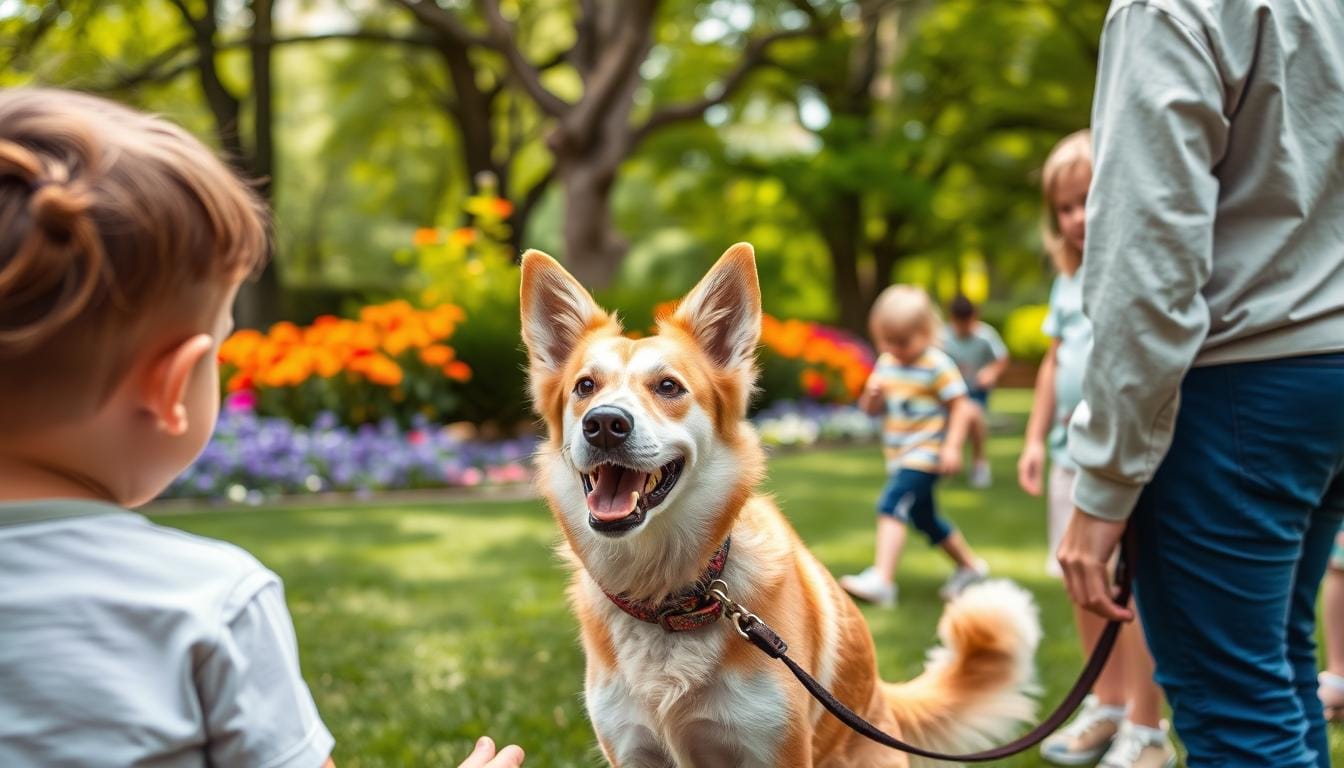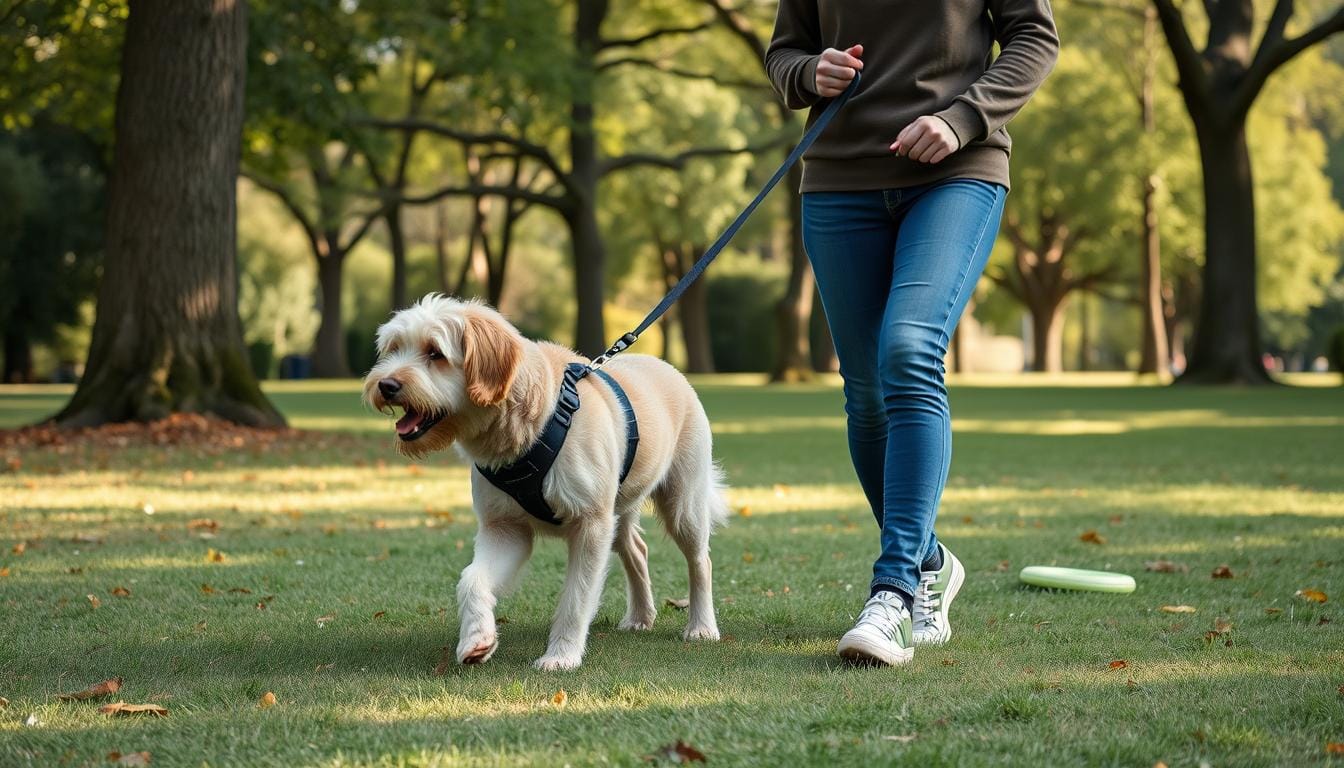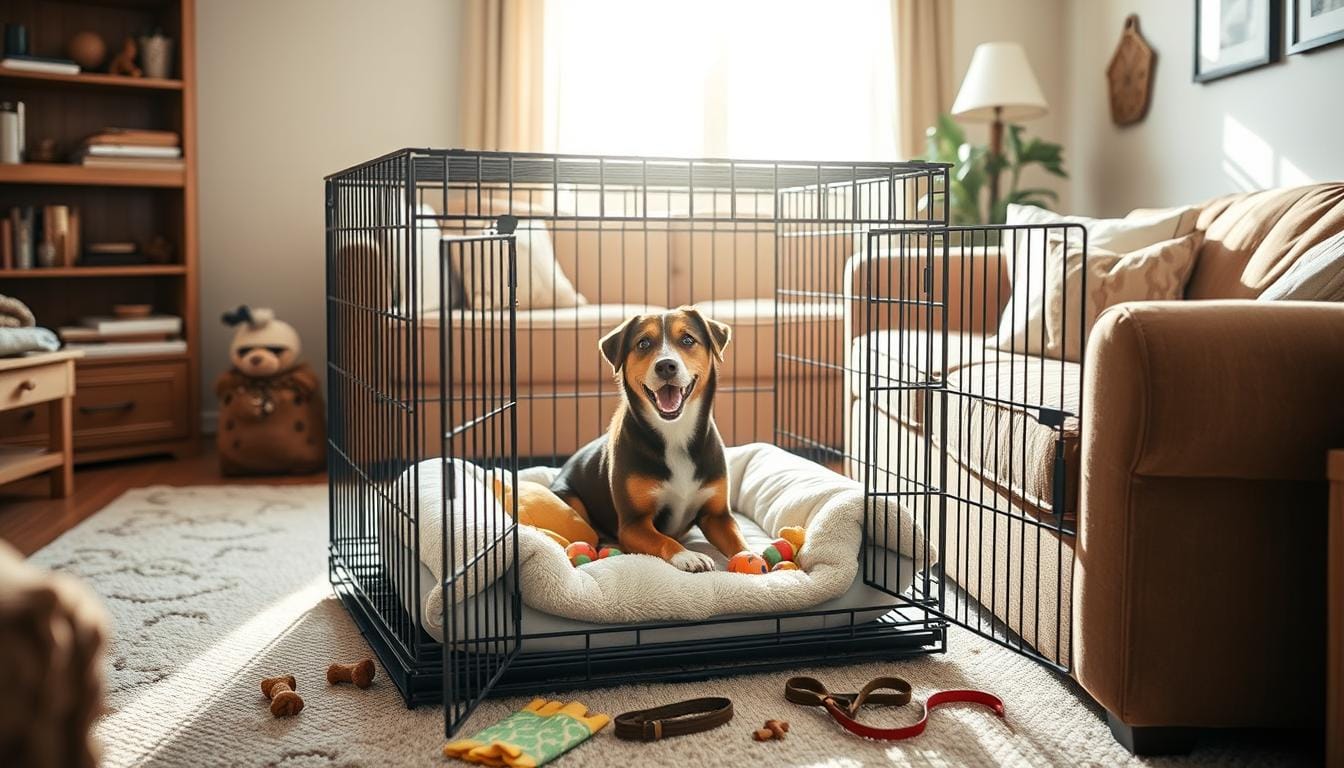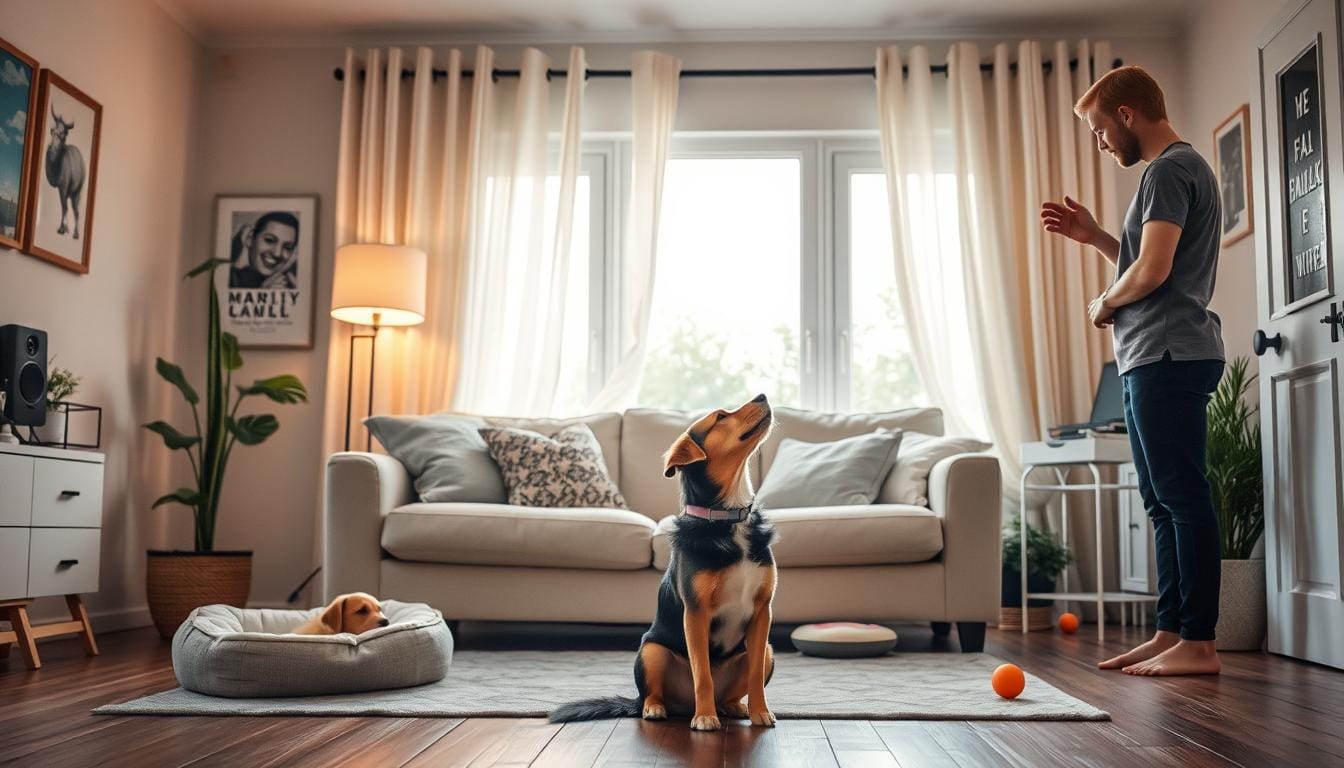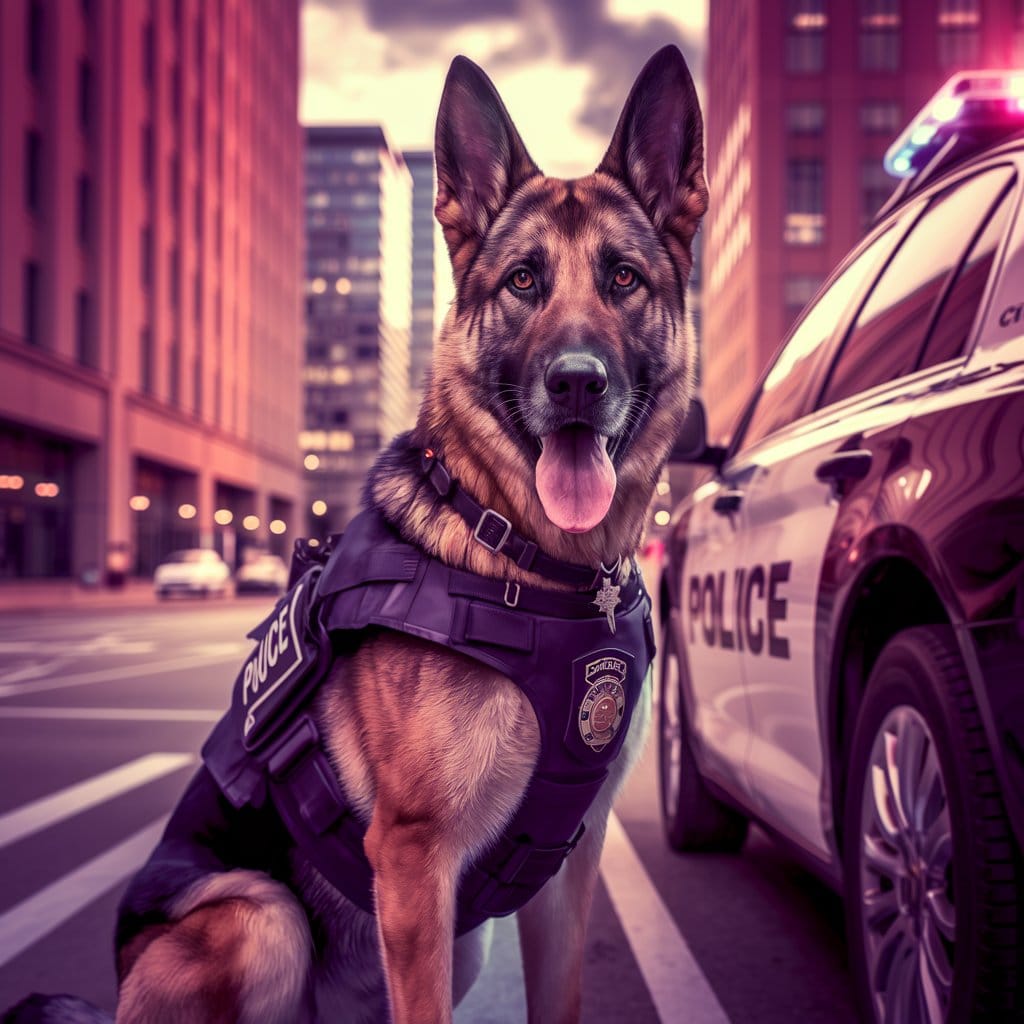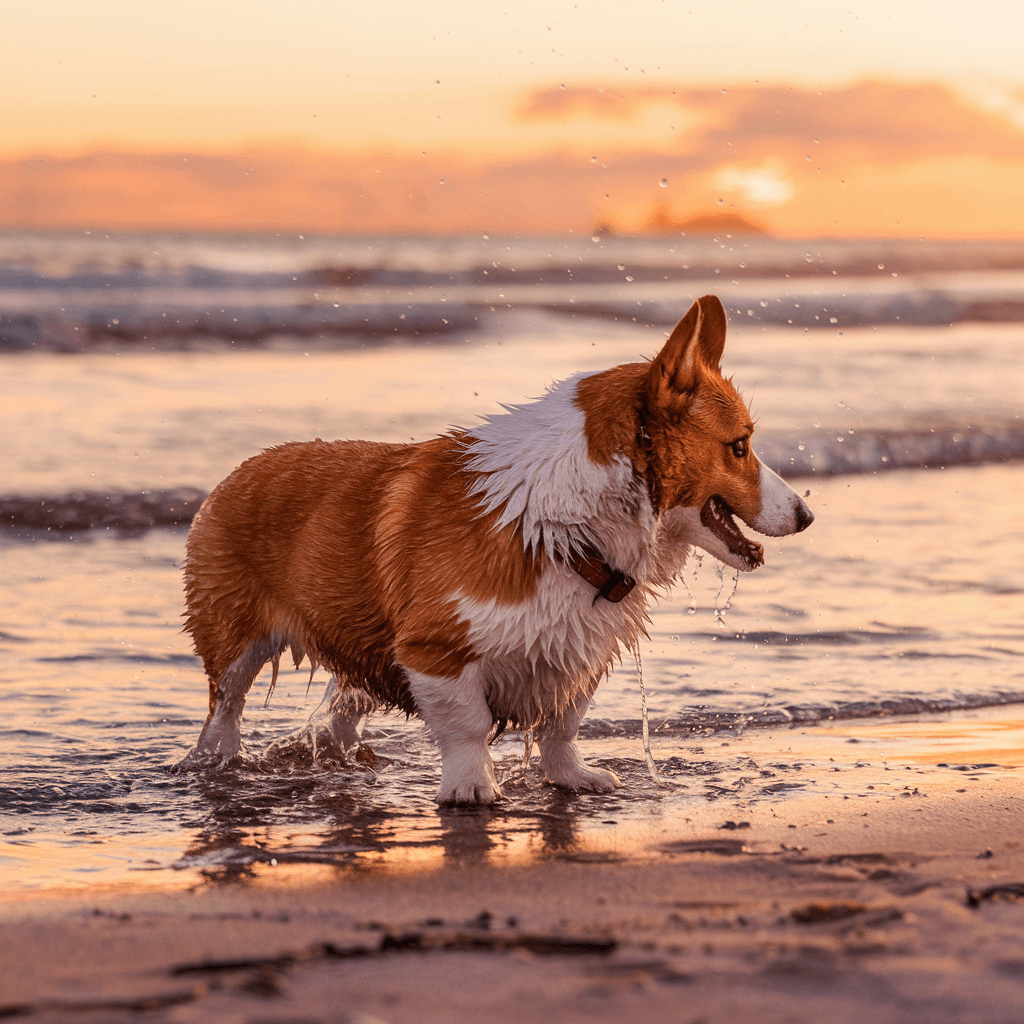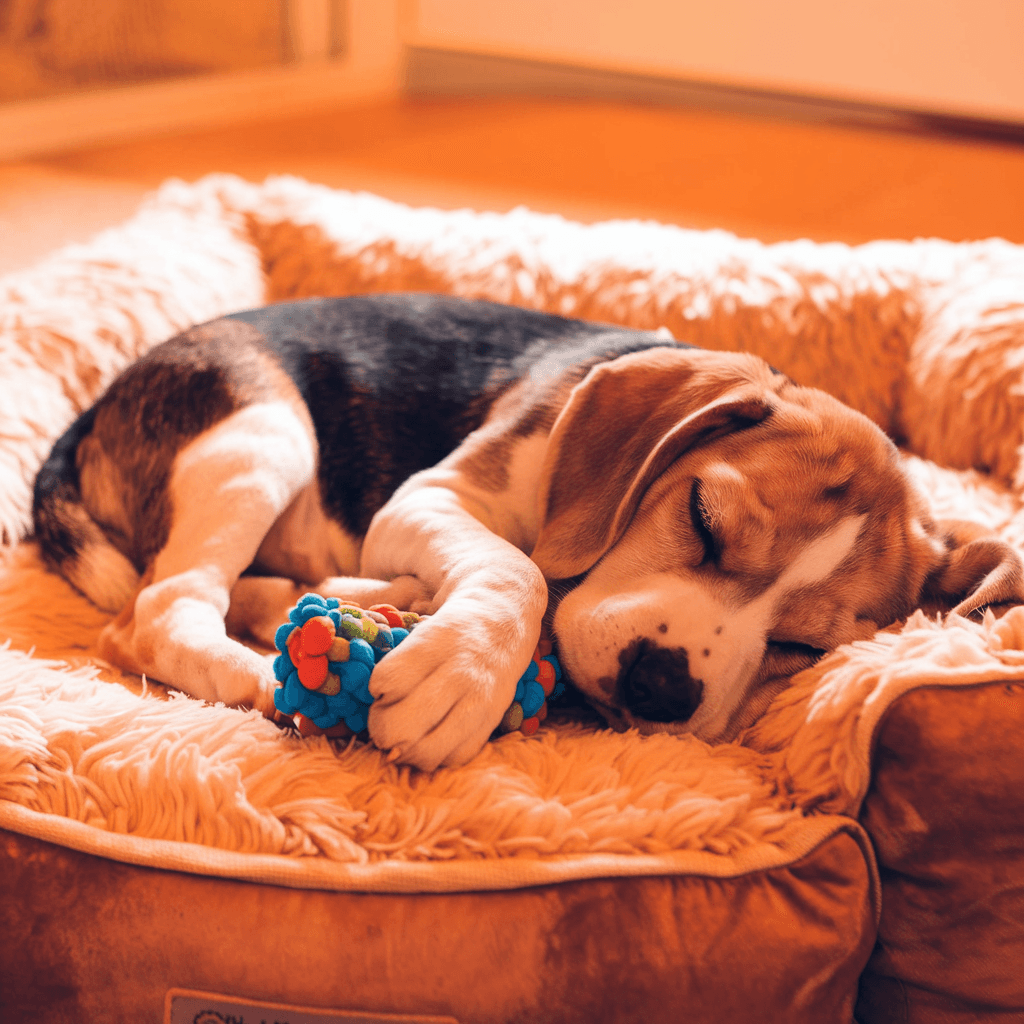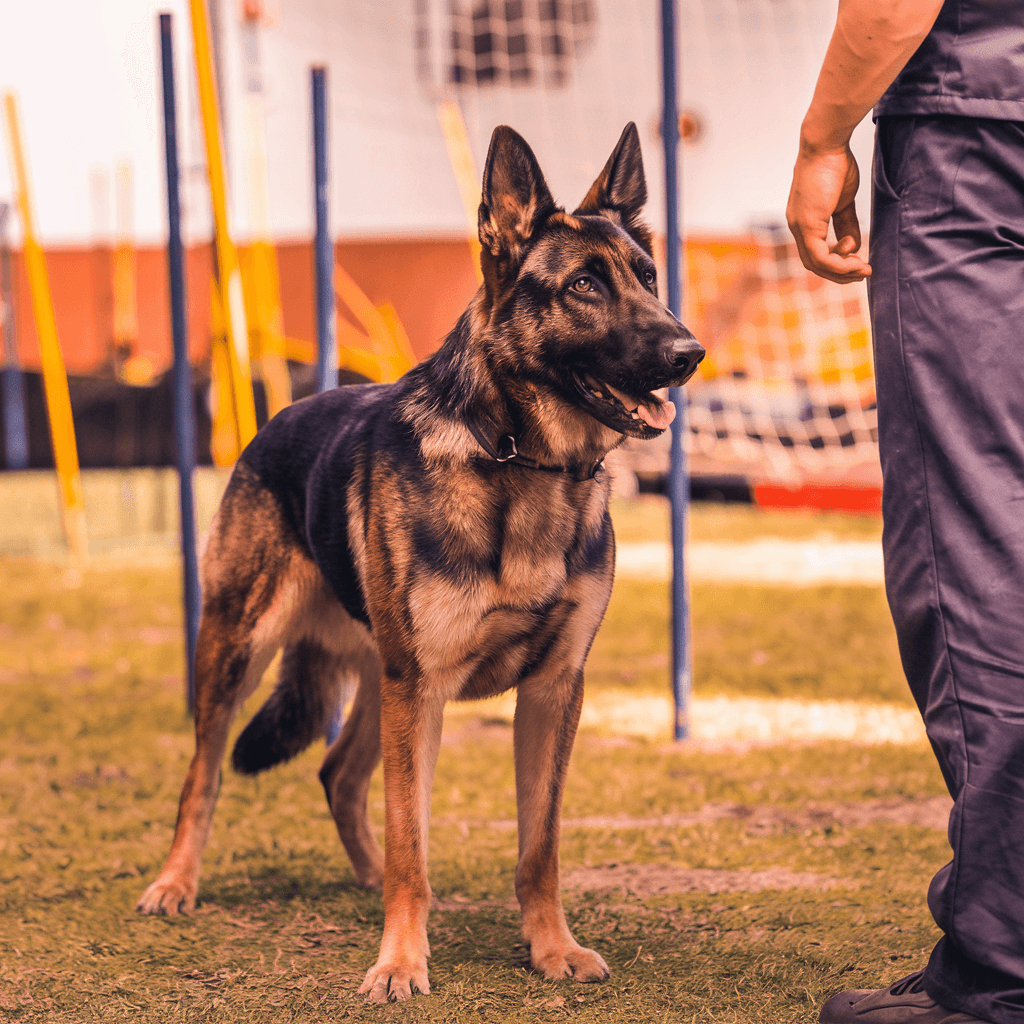Bringing a new furry friend home is exciting. But, it’s important to know that dog socialization can be tough for them. We’ll look at ways to train our pets to be friendly in new places.
Introducing dogs to new people or places needs patience. Every dog adapts at their own speed. By understanding their body language, we can make sure they have a good time.
It’s key to let dogs approach others when they’re ready. Pushing them too fast can make them defensive. We want to make sure our pets feel safe and comfortable in all situations.
Key Takeaways
- Allow dogs to initiate contact at their own pace
- Learn to read canine body language for signs of stress
- Use positive reinforcement during introductions
- Create a calm environment for new encounters
- Be patient and consistent in socialization efforts
- Prioritize early, positive experiences for puppies
- Manage interactions carefully with anxious or fearful dogs
Understanding Canine Body Language and Behavior
Learning to read your dog’s body language is crucial for puppy socialization and behavior training. It helps you create positive experiences and strengthens your bond. Let’s explore how dogs communicate.
Reading Your Dog’s Stress Signals
Dogs show stress or discomfort in different ways. Look out for these signs:
- Lip-licking
- Whale eyes (showing the whites of their eyes)
- Cowering or hunching
- Yawning when not tired
- Panting without physical exertion
Spotting these signs early helps avoid stressful situations. Understanding canine body language is key for effective communication and trust.
Recognizing Comfortable vs Uncomfortable Body Language
A relaxed dog shows:
- Loose, wiggly body
- Soft eyes
- Open, relaxed mouth
- Tail wagging at medium height
An uncomfortable dog might display:
- Stiff body posture
- Closed mouth
- Tail tucked or held high and still
- Ears pinned back
Important Signs of Fear or Anxiety
Watch for these signs of anxiety during socialization:
- Attempts to retreat or hide
- Excessive barking or growling
- Shaking or trembling
- Refusal to take treats
By recognizing these signs, you can adjust your training to make your dog feel safe and comfortable.
| Tail Movement | Emotional State |
|---|---|
| Fast, twitchy wag | Excitement |
| Slow, relaxed wag | Calm and happy |
| High, stiff wag | Aggression or stress |
| Low, tucked-under tail | Fear or submission |
Every dog is different. Pay attention to your pup’s unique cues. With patience and understanding, you’ll learn to communicate with your dog effectively, creating a harmonious relationship.
The Proper Way to Greet a Dog

Meeting new dogs can be exciting, but it’s crucial to approach them correctly. We’ll guide you through the steps to ensure a positive experience for both you and the dog in new environments.
When greeting a dog, turn sideways and lower yourself. This non-threatening stance helps the dog feel at ease. Avoid direct eye contact and speak softly. Let the dog make the first move.
If the dog approaches, pet their chest or chin instead of their head. This gentle touch is more comfortable for most dogs. Remember the three-second rule: pet for three seconds, then pause to check the dog’s reaction.
“Always ask the owner’s permission before greeting their dog. Respect their decision if they say no.”
Be mindful that not all dogs enjoy meeting strangers. According to recent studies, most adult dogs are selective about their canine friends. Forcing interactions can lead to behavioral issues.
| Dog Behavior | Percentage |
|---|---|
| Dog Social | 20% |
| Dog Selective | 60% |
| Dog Intolerant | 20% |
For dog owners, it’s essential to observe your pet’s body language during greetings. If you notice signs of discomfort, politely end the interaction. This approach ensures dog-friendly environments and positive new experiences for all.
Creating Safe Spaces for Initial Introductions
Setting up a controlled environment is crucial for dog socialization. We’ll show you how to create safe spaces for your dog to meet new people and pets.
Setting Up a Controlled Environment
A controlled environment is key for successful pet training and introductions. Choose a quiet, neutral area where your dog feels comfortable. This could be a fenced yard or a spacious room in your home.
Remove any distractions or hazards to keep the focus on the introduction.
Managing Distance and Approach
Start introductions with plenty of space between your dog and the new person or pet. Let your dog approach at their own pace. If they show signs of stress, increase the distance.
Gradually decrease the gap as your dog becomes more comfortable.
Establishing Comfort Zones
Create multiple safe spaces for your dog throughout your home. These areas should be quiet and free from foot traffic. Consider using a crate, bed, or designated corner as a retreat spot.
Feeding your dog in their safe space can help prevent resource guarding issues.
| Safe Space Tips | Benefits |
|---|---|
| Use calming music | Reduces stress |
| Provide chew toys | Mental stimulation |
| Dog-proof area | Ensures safety |
| Introduce early | Builds familiarity |
Remember, patience is key in dog socialization. By creating safe spaces and managing introductions carefully, you’re setting the foundation for positive interactions and a well-adjusted pet.
Dog socialization, pet training, friendly dogs, new places

Puppy socialization is key to raising a well-adjusted dog. Studies show 85% of dog owners focus on socializing their puppies. This ensures they behave well with other dogs and people.
Behavior training helps make dogs friendly. Dogs that are socialized are 70% less likely to be fearful or aggressive in new places. Safe social interactions boost a dog’s confidence by 80%.
The best time for puppy socialization is before they are four months old. It’s important to expose them to different surfaces, sounds, and stimuli. Dogs that experience various environments early are 60% less likely to develop phobias or anxiety later.
“Socializing your dog ensures its ability to react to the world in a healthy way, without fear or aggression.”
Positive reinforcement is crucial in socialization. Rewarding good behavior during training increases positive outcomes by 75%. This method helps create friendly dogs who are at ease in new places and with strangers.
| Socialization Aspect | Benefit | Success Rate |
|---|---|---|
| Early Exposure (up to 4 months) | Reduced Phobias and Anxiety | 60% |
| Positive Reinforcement | Improved Training Outcomes | 75% |
| Planned Social Interactions | Increased Confidence | 80% |
By focusing on puppy socialization and consistent training, we can raise friendly dogs. This not only benefits the dog but also makes pet ownership better for everyone.
Managing Home Introductions with Visitors
Welcoming guests with friendly dogs can be a joy. We’ll show you how to make it a positive experience for everyone.
Preparing Your Home for Guests
Make your home calm before guests arrive. Create a safe spot for your dog to go if needed. This reduces stress and makes the introduction better.
Step-by-Step Introduction Process
Keep your dog in a separate room when guests first come in. Let them settle, then let your dog meet them. This slow approach helps your dog feel comfortable and trustful.
Using Treats and Positive Reinforcement
Ask guests to give treats without eye contact. Reward your dog for staying calm. This makes new people a positive experience for your dog.
| Socialization Statistic | Percentage |
|---|---|
| Dogs receiving adequate socialization | 23% |
| Dogs exhibiting fear or aggression towards visitors | 35% |
| Dogs that could benefit from proper introduction training | 70% |
| Dog owners struggling with pet behavior during visits | 42% |
Never force your dog to interact. If they’re scared, tell guests to ignore them and toss treats from afar. With patience and consistency, your dog will learn to enjoy new experiences with visitors.
Special Considerations for Children and Dogs
Introducing dogs to children needs careful planning and watching. Our focus on training and making places dog-friendly is key. Kids often don’t understand dog body language, which can cause problems.
Research shows kids can only guess a dog’s feelings about 17% of the time. This misunderstanding can lead to dangerous situations. We suggest teaching kids how to safely meet and play with dogs.
- Teach children not to chase or grab dogs
- Instruct kids to avoid disturbing dogs while eating or sleeping
- Encourage children to sit calmly and let the dog approach them
Watching over kids and dogs is very important. We recommend having two adults there for the first meeting. This helps keep everyone safe and teaches good behavior. Keep these first meetings short and positive, aiming for a calm setting.
“Well-socialized dogs grow up to be friendly and happy, making successful pets.”
Good socialization means a happier, healthier life for your dog. By following these tips, we can make places where both kids and dogs feel welcome.
| Dog Bite Statistics | Data |
|---|---|
| Annual dog bites in the US | 4.7 million |
| People seeking medical attention for dog bites annually | 800,000 |
| Percentage of dog bites resulting in no injury | 81% |
| Chances of dying from a dog bite | 1 in 112,400 |
Navigating Public Spaces and New Environments
Exploring new places with your furry friend is exciting. We’ll show you how to build confidence, handle encounters, and manage stress in public areas.
Building Confidence in Different Settings
Begin slowly when introducing your pup to new places. A good rule is five minutes of gentle exercise per month of age for puppies up to a year old. This helps avoid overwhelming experiences and health problems later.
Managing Encounters with Strangers
Public outings can be stressful for dogs. Teach basic commands like sit, stay, and come. Practice in different places to reinforce good behavior.
Dealing with Environmental Stressors
Dogs may feel anxious in busy areas. Look for signs of stress like barking, panting, or trembling. Use treats or toys to distract them from stressors.
| Age (months) | Exercise Time (minutes) | Socialization Focus |
|---|---|---|
| 2-3 | 10-15 | Home, family, quiet outdoors |
| 4-5 | 20-25 | Parks, other dogs, short walks |
| 6-7 | 30-35 | Busier areas, longer walks |
| 8-12 | 40-60 | Various environments, public spaces |
Remember, sniffing is key for puppies to understand new places. Give them time for this important activity during outings. By following these tips, your pup will become a confident companion anywhere.
The Role of Positive Reinforcement in Socialization
Positive reinforcement is key in pet training and making dogs friendly. It rewards good behavior, making it a great way to socialize. Let’s see how it shapes your dog’s behavior and confidence.
Studies show dogs trained with positive reinforcement have fewer problems. This method leads to better pets and happier interactions with people and other animals.
Timing is everything when socializing your dog. The first few months are crucial. Puppies are open to new things during this time. Exposing them to different places, sounds, and animals builds confidence.
- Keep training sessions short, around 10 minutes, to maintain your dog’s attention and enjoyment
- Use treats, praise, and play as rewards for desirable behaviors
- Participate in structured puppy socialization classes to develop essential skills
Consistently linking new experiences with positive results boosts your dog’s confidence. This method teaches dogs what’s expected, making them well-behaved and confident.
Positive reinforcement isn’t just about treats. It’s about creating a safe space for your dog to learn. With patience and consistency, your dog will become a well-adjusted, friendly companion.
Common Mistakes to Avoid During Introductions
Introducing your dog to new people and places is key for their behavior and social skills. Many pet owners make mistakes that slow down progress. Let’s look at some common errors and how to avoid them for better introductions.
Forcing Interactions
One big mistake is forcing dogs to meet face-to-face on a leash. This can make them act aggressively and create bad memories. Instead, let dogs meet each other naturally in a calm place.
Overlooking Stress Signals
Not noticing your dog’s body language can cause problems. Look for signs like lip licking, yawning, or avoiding eye contact. It’s important to respect these signs for a positive social experience.
Rushing the Process
Being patient is crucial in socializing dogs. Introducing them to too many new things too fast can be too much. Let your dog take their time to adjust.
| Common Mistake | Potential Consequence | Better Approach |
|---|---|---|
| Leash greetings | Aggressive behavior | Off-leash in neutral area |
| Ignoring body language | Stress and anxiety | Observe and respect signals |
| Over-socializing | Overwhelm and fear | Gradual, positive exposure |
| Dog park introductions | Conflict and stress | Controlled, one-on-one meetings |
| Crate introductions | Perceived threat | Use of neutral spaces |
By avoiding these common mistakes, we can help our dogs have positive social experiences. This builds their confidence and good behavior.
Training Techniques for Fearful or Shy Dogs
Training fearful or shy dogs needs a special approach. Fear often comes from genetics or lack of experience. Our aim is to make these dogs feel safer and more confident.
Counter-conditioning is a helpful technique. It pairs positive experiences with things that scare the dog. For instance, treats when a new person is around can help a dog feel better about strangers.
Desensitization is also key in socializing puppies. We start with small steps, slowly increasing exposure to what scares them. This helps them get used to it without feeling too scared.
“Play is a powerful tool for helping shy and fearful dogs learn how to cope better in our world.” – Amy Cook, Ph.D.
The Play Way method, by Amy Cook, is very effective. It uses fun play to build confidence and trust in fearful dogs. It keeps them safe, letting them know what’s scary without feeling threatened.
| Traditional Methods | Play Way Approach |
|---|---|
| Focused on obedience | Emphasizes fun and relaxation |
| May increase anxiety | Reduces stress and builds confidence |
| Less effective for very fearful dogs | Successful with extremely shy dogs |
Patience is key in this journey. Fear can make learning hard, so progress might be slow. But with consistent, positive training, most fearful dogs get better. They learn to trust and feel more at ease.
Building Long-term Socialization Success
Creating dog-friendly environments is key for long-term socialization. Dogs have a prime socialization window that closes by six months. Early exposure to new things is vital, especially for puppies between 3-16 weeks.
Puppies grow a lot in their first four months. This is when their brains develop the most.
Maintaining Consistency
Consistent guidance and manners training are crucial. We suggest at least one safe outing a week. Group walks and playdates are great for starting.
Remember, exposure to other dogs must be positive. This prevents bad habits from forming.
Progressive Exposure Techniques
Introduce your puppy to new things slowly. For example, Emma, a golden retriever puppy, was introduced to six categories early on. This gradual approach helps build confidence and good behavior.
Tracking Progress and Adjusting Approaches
Social skills work can be tough for dogs. Give them time to rest and recover between sessions. Keep track of their progress and adjust your training as needed.
If your pup missed early socialization, start as soon as you can. Consider a professional trainer for help. With positive reinforcement, treats, and practice, our dogs can thrive in dog-friendly places and new experiences.

